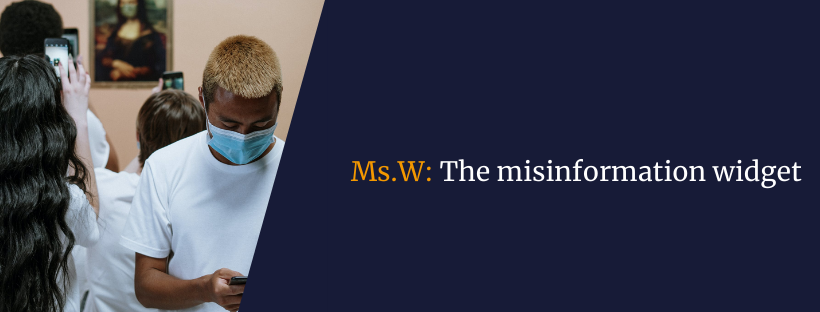Ms.W: The misinformation widget
By Adolfo Antón Bravo, David Arroyo and Sara Degli Esposti, CSIC The COVID-19 pandemic has made clear the risks of online misinformation. Are the vaccines safe? Should we keep wearing masks? On such questions, social media has become a minefield of wrong, misleading or false information – with real-world consequences. Surely there’s a way that we, when online, can more easily check the trustworthiness of a post? That’s the aim of Ms.W, the Misinformation Widget being developed by the EU-funded TRESCA project. It is a bit of software, that can run as a phone app, to help judge whether what you are reading is reliable or not. In short, it’s an online vaccine against today’s online “infodemic.” An infodemic, according to the World Health Organisation, is “”an overabundance of information —some accurate and some not— that makes it hard for people to find trustworthy sources and reliable guidance when they need it”. It can include misinformation: postings that are wrong, perhaps by accident, for many reasons. In posts about science, the technical vocabulary can be misunderstood or misinterpreted. The source’s expertise, reputation or reliability aren’t always easy to check. And misinformation frequently overlaps with disinformation – deliberately false or misleading information posted for political or economic gain. There are plenty of examples. In early 2020, an online hoax about the benefits of bleach-based alcohol for use against COVID-19 led to the hospitalisation of hundreds. The challenge of separating fact from “faction” gets even harder when dealing, not just with text, but also with “memes.” Though the term originated in evolutionary biology, most commonly today a meme is an image, video, or piece of text that is copied and spread rapidly by Internet users, often with slight variations. They are often funny; they catch your attention, and you forward them to your friends. A classic example: memes about next-generation 5G mobile phone systems – some harmless, some harmful. The latter, see figure 1 for an example, helped spread unfounded fears that 5G transmission towers were somehow connected with COVID-19. (Spoiler alert: they aren’t.) Figure 1: A typical online meme – in this case, making fun of false claims that 5G mobile phone towers somehow spread COVID-19. (Surprise: they don’t.) Source: https://www.reddit.com/r/meirl/comments/fxszo6/meirl/ Another problem: Images or text can be easily taken out of context online. According to Newtrals.com, a fact-checking news site, a WhatsApp text circulated widely claiming that in India only people who are vaccinated were getting COVID. It was based on an interview with a doctor in New Delhi – but taken entirely out of context. Why? To spread panic? Attract attention? Or was it part of something more nefarious? How to deal with this? The answer isn’t simple. Detecting, fact-checking and taking down dodgy content is harder than it might seem. There are already many online services that offer fact-checking help, in one way or another. But there are not always clear-cut lines separating good-faith information, opinions, fake news, disinformation, and incomplete or misleading information. Thus, there is a need for trustworthy oversight mechanisms that incorporate algorithmic fairness and accountability principles. The Misinformation Widget, or Ms.W, is a science-communication tool being developed by TRESCA, a Horizon 2020 project on scientific disinformation. Ms.W is both a methodology and a toolkit. It is a methodology in the sense that it indicates how to use a variety of online resources. It integrates a number of existing services that help users perform different tasks associated with content verification: news gathering, fact checking, blacklisting of fake sites, reverse image search, and more. It will also include new algorithms coming from current research about the application of machine learning to guide information curation and combat disinformation. It will help users track online news and their authors, and will help them evaluate the accuracy, credibility and trustworthiness of written and visual content. Ms.W can be used as a web service or a mobile app. Ms.W will be available in early 2022, as part of TRESCA’s free online course about scientific disinformation. Now in production, the TRESCA course, to be available on Coursera, will be a seven-week set of lectures and supporting documents, aimed at researchers, communicators and journalists, and exploring how to communicate trustworthy knowledge in the digital world. Stay tuned to join us there online – and stay away from COVID towers.
